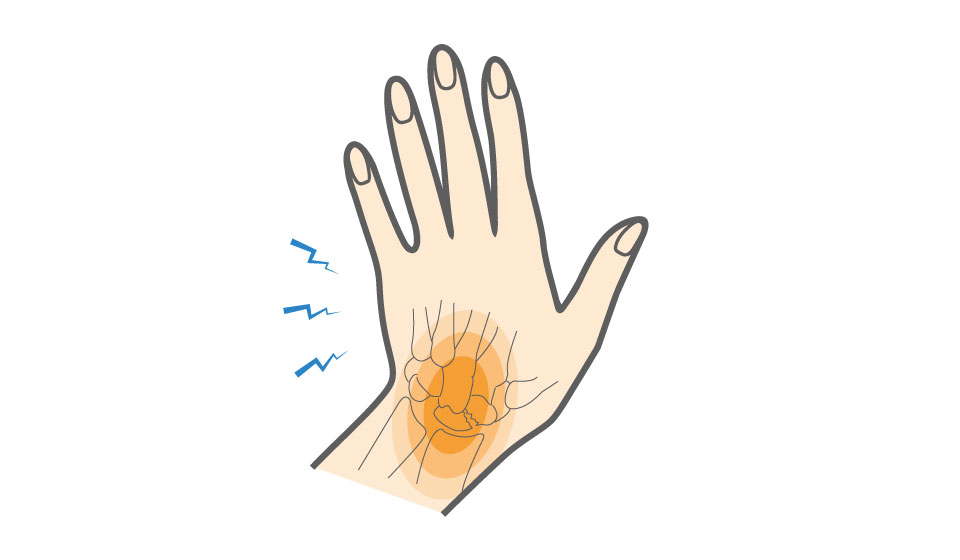The scaphoid bone is one of the eight carpal bones in the wrist that connect the forearm bones to the bones of the hand. There are two rows of carpal bones: the row closer to the forearm and the row closer to the hand. The scaphoid bone is an important and unique bone in that it is the only carpal bone that spans between the two rows. This unique feature of the scaphoid makes it especially susceptible to injury during a fall on an extended wrist. In fact, the scaphoid is the most commonly injured carpal bone. It is important to know if you have a scaphoid fracture, as these breaks have a relatively high chance of not healing if they are left unrecognized and untreated.
Scaphoid Fracture Causes, Symptoms & Treatment Options
The scaphoid bone is one of the eight carpal bones in the wrist that connect the forearm bones to the bones of the hand. There are two rows of carpal bones: the row closer to the forearm and the row closer to the hand. The scaphoid bone is an important and unique bone in that it is the only carpal bone that spans between the two rows. This unique feature of the scaphoid makes it especially susceptible to injury during a fall on an extended wrist
Overview
Overview

What causes Scaphoid Fracture?
Scaphoid fractures commonly happen after a fall on the palm of an outstretched hand. The force and position of the wrist cause the scaphoid bone to fracture. Scaphoid fractures can occur in any sport in which falling on the hands is common, such as:
• Skiing, snowboarding
• Skateboarding, in-line skating
• Bicycling
• Soccer
• Football
• Basketball
Symptoms
After a fall, athletes usually first experience pain. Often there are no obvious signs of injury, and pain may decrease after a few days. As a result, some athletes may pass off their symptoms as a simple wrist “sprain.” You may have a scaphoid fracture if you have a history of a fall or some other type of trauma and you experience one or more of the following symptoms:
• Pain on the thumb side of the wrist
• Tenderness at the base of the thumb in what’s called the anatomical “snuff box” (the concave hollow on the outside of the hand created by the two extensor tendons of the thumb)
• Swelling or bruising (black and blue discoloration may be present, but is often not that severe)
When to see a doctor
If you injured your wrist and have symptoms of a possible scaphoid fracture, you should obtain medical treatment. Your doctor will ask about any injuries you have sustained. A physical examination will look for tenderness, swelling, and bruising, as well as test range of motion. Your doctor will also order an x-ray to determine if you have a fracture. X-rays may not always show a scaphoid fracture, particularly if the bones are still in alignment (non-displaced). If your doctor suspects a fracture, your wrist may be placed in a splint to keep it secure. X-rays or other imaging tests will be taken again a week or two later to confirm the diagnosis and check healing progress. If your doctor feels there is a good chance you may have a scaphoid fracture that has not shown up on x-rays, a CT scan or MRI will often be ordered to confirm that there is no break.
Non-operative treatment
Treatment for a scaphoid fracture will depend on the location of the fracture, in part because the blood supply to the scaphoid varies for different locations of the bone. For example, fractures closer to the forearm are harder to heal because of the lack of blood supply to this area. Treatment will also be determined by the degree of displacement of the fractured bones. Scaphoid fractures that are non-displaced can be treated without surgery, as they typically heal with immobilization. Conservative treatment usually involves:
• Immobilizing the wrist with a splint for the first few days
• Switching to a cast once any swelling goes down, for six weeks to six months
• Intermittent x-rays to check fracture healing, and changing the cast if it gets loose
• Hand therapy after the cast comes off
Try these exercises to help address your condition:
Below is a PDF of the exercise program.
Surgical Treatment
If your scaphoid fracture is displaced or located closer to the forearm, your doctor may recommend surgical treatment. Metal screws or wires may be used to secure the fractured bones together so they can heal. Surgery usually improves outcomes for displaced fractures and can reduce the amount of time your wrist needs to be immobilized. Your orthopedic surgeon will advise on the best course of treatment for you.
VIDEO: “Scaphoid Fracture Open Reduction and Internal Fixation (ORIF)” from Viewmedica.com
Recovery
Scaphoid fractures can take a long time to heal. With or without surgery, athletes can expect to wear a cast for anywhere from six weeks to six months. During this time, activities that can re-injure the wrist should be avoided, such as carrying heavy loads or playing sports that could place stress on the wrist. Engaging in hand therapy will also be important during your recovery to build back strength and range of motion in your wrist.

